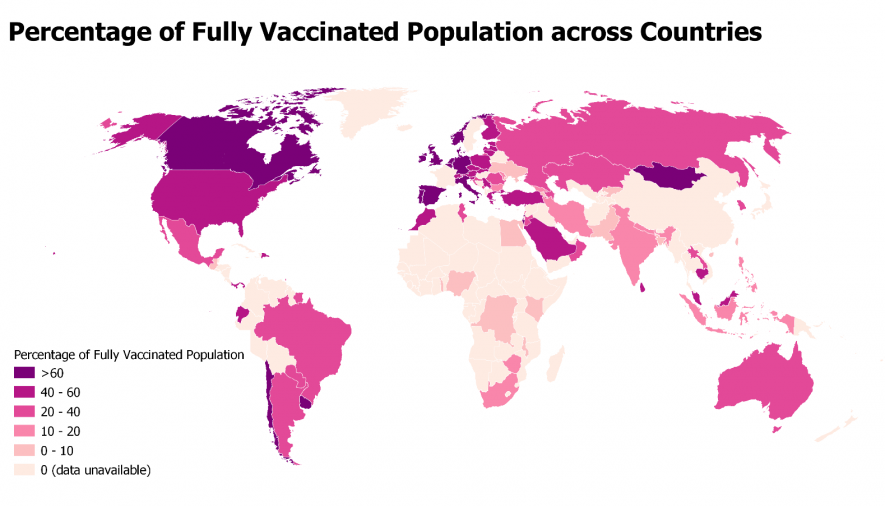Aggravating Inequalities in Vaccine Distribution – Does the Developed World Care at all?
“We still see shocking inequities in access to vaccines…. More than 5 billion vaccines have now been administered globally, and almost 75% of them have been in just 10 countries.” said the World Health Organisation (WHO) Director-General Tedros Ghebreyesus.
Calling for a moratorium on booster doses of COVID-9 vaccines, the WHO in its statement on August 10, had warned that given the “global vaccine supply constraints, administration of booster doses will exacerbate inequities by driving up demand and consuming scarce supply while priority populations in some countries have not yet received a primary vaccination series.”
Vaccine Inequalities Exacerbating Overtime
After the vaccines were developed, countries got into a race to secure as many doses as possible. In fact, this had started even while the vaccine development was in process, as countries secured vaccine supply through advanced purchase agreements.
The race was limited to the rich countries only which hogged the initial supply. The WHO made efforts to build platforms such as the COVAX to ensure equity in the distribution of vaccines across countries. However, these efforts have failed as, to date, only a small fraction of the population in developing countries has been fully vaccinated, while in most of the developed countries the percentage of the fully vaccinated population is more than 50%.
Over the months, this inequality in vaccine access has aggravated. In Figure 1 we see the contrast in the percentage of people fully vaccinated across continents and some major developed countries. We have plotted the data at four points in time ( March 1, May 1, July 1 and September 1 2021) to show how inequalities have increased over time.
As of May 01, 2021, while in Africa 0.4% of the population had got fully vaccinated, Canada had got 2.9% of its total population vaccinated. Asia (excluding China) was close to Africa’s proportion with only 1.4% of the population fully vaccinated. The United States and the United Kingdom had a higher share of the population – 31% and 22% respectively – which was fully vaccinated.
However, if we look at this scenario after about four months, on September 01, we see the stark inequality. While in Africa the fully vaccinated proportion has increased to only 2.9%, Canada has fully vaccinated about 67% of its population. The European Union (EU), UK, US have all been able to vaccinate more than 50% of their population while Asia (excluding China) managed to vaccinate only 10% of the population and South America has reached 31%, led by relatively advanced countries in the group such as Chile.
A look at the global vaccination status (Figure 1) shows that most of the developed countries have got a substantial portion of their population vaccinated (>40%) while the poor developing countries of Africa (<5%) and Asia (<20%) are still far behind.

Note: These percentages are as a proportion of the total population; numbers would be higher when taken as a percentage of eligible age-group of 18-years and above.
Source: Our World in Data
Offering Booster Doses against WHO’s Appeal
The WHO had earlier appealed and called for a moratorium on boosters until at least end-September. The DG WHO reiterated this call on September 1 and expressing anguish over the inequalities in vaccine coverage, said “Some countries are now rolling out booster doses to fully-vaccinated people when millions of people around the world have not even received their first dose.”
In the absence of more data on the need or efficacy of a booster dose, the WHO has been advising that “introducing booster doses should be firmly evidence-driven and targeted to the population groups in greatest need.” While some countries such as Cambodia and Thailand had started giving booster doses to the front line health workers since mid-July/August with priority to medical staff, government employees and frontline workers, Israel has announced and has started giving booster doses to all above 12-years of age. And there are reports of Israel even contemplating a fourth dose of vaccine if the need arises.
Other developed countries such as Germany, France, Czech Republic, and the UK are planning the rollout for the elderly and the section of the population whose immunity is compromised.
Most recently, the US government announced the administration of booster doses from September 20. However, the federal health agencies in the US (the Food and Drug Administration and the Centre for Disease Control and Prevention) have reportedly advised against the blanket recommendation of booster dose across the population, urging the government to make the rollout slow and more limited while more data are collected on its efficacy.
Failed Commitments under COVAX
The WHO is still struggling to make the COVAX platform work. The initial aim of the COVAX platform was to make available nearly 2 billion vaccine doses for lower-income countries by the end of 2021. This target has been revised as per the latest COVAX supply forecasts to 1.4 billion, as it expects another 1.1 billion to be available between September and the end of 2021. By August-end the COVAX had released 330 million doses for delivery, with 236 having been delivered to 139 countries. As the WHO DG informed, as against the 1 billion doses promised by high-income countries as donations, less than 15% of those doses have materialised.
India, which had started on an upbeat note in supplying vaccines to other developing countries and COVAX, fell out of the global supply chain completely. India, due to the high number of cases during the second wave and now a possible third wave, reneged on its commitments. By May-end in 2021, India had supplied a total of 66 million vaccines, with about 20 million through COVAX. The vaccination programme in a number of countries was halted due to this.
In such circumstances, China became the largest supplier of vaccines to the developing countries, including the South Asian countries which have relied on Chinese vaccines, signing non-disclosure of prices deals with the Chinese Government.
Cuba and Russia are other countries that have been supplying vaccines to various developing countries, even though the WHO has not yet given emergency use approval to these vaccines including India’s indigenously developed vaccine Covaxin. In fact, Cuba and Russia have even offered to share the vaccine technology developed by them with manufacturers in other countries.
The urgent need today is the transfer of vaccine manufacturing technology, know-how and intellectual property to many more countries. The key bottleneck is that only a few global manufacturers have monopoly power. There has been no progress on the TRIPS waiver proposal which is still under negotiations and has become a victim of delaying tactics by the developed countries.
In the declaration by the G-20 Health ministers who met on September 5-6, 2021 to promote strong multilateral cooperation towards ending the COVID-19 pandemic, among other issues, there was a reiteration of support to the WHO’s vaccination goals and to the ACT accelerator and COVAX facilities.
Expressing his anguish over increasing vaccine inequality in a subsequent media briefing on COVID-19, the WHO DG called for “an extension of the moratorium until at least the end of the year, to enable every country to vaccinate at least 40% of its population.”
“We don’t want any more promises. We just want the vaccines”, he retorted.
"Data inputs and support with the Map provided by Elora Chakraborty and Peeyush Sharma"
Get the latest reports & analysis with people's perspective on Protests, movements & deep analytical videos, discussions of the current affairs in your Telegram app. Subscribe to NewsClick's Telegram channel & get Real-Time updates on stories, as they get published on our website.
























